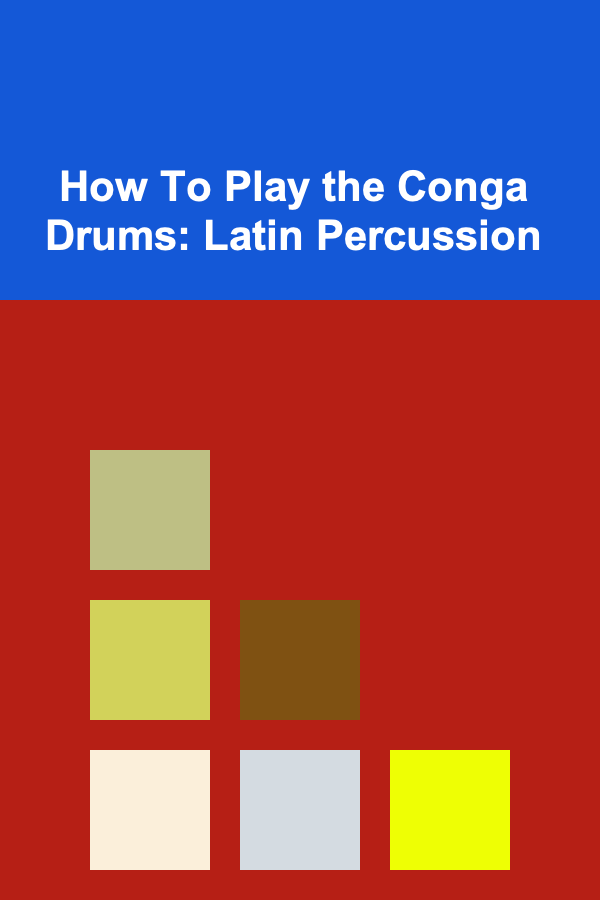
How To Play the Conga Drums: Latin Percussion
ebook include PDF & Audio bundle (Micro Guide)
$12.99$6.99
Limited Time Offer! Order within the next:

The conga drum is one of the most iconic and essential instruments in Latin music. With its rich history and distinctive sound, it plays a central role in the rhythm section of many genres such as salsa, mambo, and rumba. Whether you're a complete beginner or someone who's already familiar with percussion instruments, learning how to play the conga drum offers a rewarding challenge that connects you with centuries of musical tradition.
In this article, we'll dive deep into the world of the conga drum, exploring its history, the different types of conga drums, the basics of technique, and essential playing patterns. By the end of this guide, you'll have a solid understanding of how to approach playing the conga and be on your way to mastering this extraordinary instrument.
The History of the Conga Drum
The conga drum, also known as "tumbadora" in Cuba, has roots that trace back to West Africa, particularly to the Yoruba people. These drums were brought to the Americas through the transatlantic slave trade, where they became integral to Afro-Cuban music. Over time, the conga developed and evolved into the instrument we know today, with a distinctive cylindrical shape and a deep, resonant tone.
In the 1940s, the conga became increasingly popular within the Cuban and Latin American music scenes. Artists like Chano Pozo and Tito Puente helped elevate the instrument to new heights, bringing it into mainstream jazz and Latin dance music. The conga is now a staple in salsa bands, jazz ensembles, and many other Latin and Afro-Caribbean music genres.
Types of Conga Drums
Before delving into how to play the conga, it's important to familiarize yourself with the different types of drums in the conga family. While there are variations across different regions, the most commonly used congas are:
1. Conga (or Tumbadora)
The standard conga drum is a cylindrical percussion instrument made of wood or fiberglass, typically 28 to 30 inches tall. The conga's deep, resonant sound is ideal for both melodic and rhythmic functions. This is the drum most often associated with Latin percussion and is used in many different musical contexts.
2. Quinto
The quinto is the smaller, higher-pitched member of the conga family. It is typically used for more melodic and soloistic lines. The quinto produces sharp, bright tones and is often employed in intricate rhythmic patterns or solo breaks in Latin percussion.
3. Tumbadora
The tumbadora, or "tumba," is the largest conga drum, producing the lowest, deepest tones. It serves as the foundation of the conga section, keeping the rhythm steady and providing a strong, resonant base. In a typical conga setup, the tumbadora will handle the basic "downbeats" and foundation rhythms.
4. Super Tumba
An extension of the tumbadora, the super tumba is used in some specific styles of Latin music. Its larger size and low pitch make it a perfect complement to the other drums in the conga family.
5. Conga Heads
Congas have different types of drumheads, most commonly animal skins like cowhide or synthetic materials such as mylar. The choice of drumhead significantly affects the timbre and resonance of the drum. Traditionalists tend to prefer animal skins for their warm, rich tones, while synthetic heads are known for being more durable and resistant to environmental changes.
Basic Conga Drumming Techniques
Playing the conga drum requires not just rhythm, but also the right hand technique. The way you strike the drum will influence the quality of the sound produced. Let's go over some basic techniques that will form the foundation of your conga playing.
1. Hand Positioning
To get the best sound out of your conga drum, you need to ensure proper hand placement. Your hands should be relaxed, and you should strike the drum with the pads of your fingers, not your fingertips. This ensures a fuller, rounder sound.
The basic hand positions include:
- Open Hand: This is the most common position where you strike the drum with the open palm. This produces a resonant, deep sound, especially when striking near the center of the drum.
- Edge or Tip: When you strike the edge of the drum near the rim, you get a higher-pitched "slap" sound. This is an essential technique for more intricate rhythmic patterns.
- Thumb Stroke: A thumb stroke is typically used to add percussive accents, and it is executed with the thumb pushing down on the center of the drumhead.
- Palm Stroke: A palm stroke is used for producing lower tones and is executed by gently pressing the palm onto the drumhead. This technique is often used in combination with other strokes to create a dynamic range of sounds.
2. Striking the Drum
There are several common strokes used in conga playing. Here are a few of the basic ones you should learn to master:
- Bass Tone (Open Tone): This is produced by striking the drum with your open palm near the center of the drumhead. It produces a deep, resonant sound.
- Tone: A tone is produced by striking the drum with your fingers spread out, creating a sound that is brighter than the bass tone. It's typically used to create a rhythmic pattern that forms the backbone of the music.
- Slap: The slap is one of the most distinctive sounds in conga playing. It is created by striking the drum near the edge of the drumhead with the fingers. This produces a sharp, percussive sound that adds energy and intensity to the rhythm.
- Muffled Tone (Dead Stroke): A dead stroke is when you strike the drumhead but immediately dampen the sound by pressing your hand lightly on the drumhead. This produces a muted sound, and it's useful for creating rhythmic variations.
- Finger Rolls: This technique involves rapidly alternating between your fingers to create a smooth, continuous sound. Finger rolls are often used to embellish a rhythm or add complexity to the overall pattern.
3. Hand Movements
In addition to the proper hand positions and striking techniques, it's important to learn how to move your hands quickly and fluidly. Smooth hand transitions and speed are key to playing complex rhythms. As you gain more experience, you'll find that using a relaxed wrist and arm will help reduce tension and allow for greater control.
4. The Role of the Conga Player
In Latin percussion, the conga player has an essential role in laying down the rhythm and driving the music forward. The conga is often used to provide both the foundation of the rhythm section and occasional melodic accents. A good conga player will have an intuitive sense of timing and rhythm, knowing when to lay back and when to push the groove forward.
Understanding Conga Patterns
One of the most important aspects of learning how to play the conga is mastering the rhythmic patterns, or "tumbaos." These patterns are the heart and soul of conga playing, and they form the framework for most Latin music genres. While each style has its own unique patterns, some common tumbaos include:
1. Basic Tumbao
The basic tumbao pattern is one of the first patterns most beginner conga players learn. This pattern consists of a series of beats that emphasize the offbeats, creating a syncopated rhythm that drives the music. The pattern is typically played with both hands and often involves alternating between bass tones and slaps.
2. Salsa Tumbao
In salsa, the conga tumbao pattern is more intricate and syncopated. This pattern involves a combination of tones and slaps, and it often includes cross-rhythms that interlock with other percussion instruments. Salsa conga patterns help maintain the groove and add dynamic energy to the music.
3. Rumba Tumbao
Rumba is one of the oldest Afro-Cuban music genres and has a unique conga pattern that is both expressive and rhythmic. The rumba tumbao is slower and more deliberate, with a focus on deep tones and resonant sounds. It is often used in soloistic passages and traditional rumba performances.
4. Mambo Tumbao
Mambo is a fast-paced genre with complex conga patterns. The mambo tumbao is typically syncopated and emphasizes offbeats. In mambo music, the conga player is often required to perform quick fills and improvisational flourishes that add excitement to the rhythm.
5. Cha-cha-cha Pattern
The cha-cha-cha rhythm is another popular Latin style that features a steady, unhurried conga pattern. This rhythm is based on a simple but effective tumbao that emphasizes the "one" beat while incorporating syncopated offbeats for flavor.
Developing Speed and Accuracy
As with any musical instrument, playing the conga well requires practice. Developing speed and accuracy is essential for becoming a proficient conga player. Start slow with basic patterns, focusing on clean, crisp strokes. Gradually increase your speed as you become more comfortable with the rhythms.
1. Hand Strength
To play the conga well, you need to build strength in your hands and fingers. Practice exercises that strengthen your fingers, wrists, and forearms. This will help you maintain control during fast passages and reduce fatigue during longer performances.
2. Rhythmic Precision
Rhythmic precision is key to playing the conga effectively. Use a metronome to help keep your timing consistent and practice with different time signatures to build your versatility. Precision in your rhythmic execution will ensure that your conga patterns are tight and lock well with the rest of the band.
3. Consistency
When learning the conga, it's important to practice regularly to develop muscle memory. The more you practice, the more natural your playing will become. Try to incorporate both basic and advanced patterns into your practice sessions to keep things interesting and challenging.
Conclusion
The conga drum is an exciting and rewarding instrument to learn, offering endless possibilities for rhythmic expression. Whether you're playing in a salsa band, a jazz ensemble, or a solo performance, the conga's unique sound and rhythmic versatility make it a key instrument in Latin percussion. By learning proper techniques, understanding the different types of congas, and mastering key rhythmic patterns, you'll be well on your way to becoming a proficient conga player. Keep practicing, stay focused, and let the rhythm guide you as you explore the world of Latin percussion.

How to Involve Kids in Budgeting Basics
Read More
How to Make Your Home Party Kid-Friendly with Fun Activities
Read More
How to Reduce Sauces for Concentrated Flavor
Read More
How to Personalize Your Email Campaigns
Read More
How to Write Meditation Scripts Focusing on Body Scan Techniques
Read More
How to Ace Your College Application Essays: A Checklist for Success
Read MoreOther Products

How to Involve Kids in Budgeting Basics
Read More
How to Make Your Home Party Kid-Friendly with Fun Activities
Read More
How to Reduce Sauces for Concentrated Flavor
Read More
How to Personalize Your Email Campaigns
Read More
How to Write Meditation Scripts Focusing on Body Scan Techniques
Read More